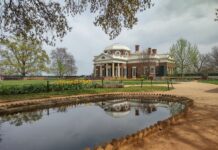My favorite vantage point along Philadelphia’s Benjamin Franklin Parkway is an unorthodox one I discovered recently while trying, unsuccessfully, to cross from the Franklin Institute to the Free Library with only seconds remaining on the crosswalk sign. Instead I ended up stranded on the traffic island in the middle of the six-lane thoroughfare. To my immediate right I could see kids in street clothes and bathing suits wading in the shallow basin of the magnificent Swann Memorial Fountain. Further southeast, I took in William Penn towering over the city from his perch atop City Hall. Gazing northwest I couldn’t miss the distinctive frieze of the Philadelphia Museum of Art. The tree-lined street and swirl of traffic made me feel like I could be in the middle of a European city, but I was glad to be in Philadelphia, one of my favorite cities stateside.
Even in a city positively bulging with art and design, the area around the Ben Franklin, known as the Parkway Museums District (http://www.parkwaymuseumsdistrictphiladelphia.org), is an embarrassment of riches that includes parks, public art and museums. Originally known as the Fairmount Parkway, the diagonal boulevard was designed by Jacques Gréber and completed in 1926, more than 60 years after the project was originally proposed. Its cultural landmarks followed soon after when the main branch of the Free Library of Philadelphia opened in 1927. What’s now known as the Philadelphia Museum of Art and the Rodin Museum opened in 1928 and 1929, respectively.
 My current foray into town is to see the parkway’s newest inhabitant, the Barnes Foundation’s Philadelphia campus, which opened in May. But two days in the city provides time to catch up with other institutions along the parkway, too, if only I can narrow my choices.
My current foray into town is to see the parkway’s newest inhabitant, the Barnes Foundation’s Philadelphia campus, which opened in May. But two days in the city provides time to catch up with other institutions along the parkway, too, if only I can narrow my choices.
Anyone who visited the Barnes Collection in its former campus in Merion, Pa., will be struck by the contrast of the contemporary, streamlined new building with the cozy domestic setting of the old site. In addition to a new exhibition gallery, the Philadelphia campus boasts a research library, classrooms and a much welcome coffee shop and café.
But some things haven’t changed. Reserving tickets before your visit is still highly recommended. (“It must be better than the original,” grumbled a woman in a purple T-shirt after being told on a Thursday morning that the only available tickets through Sunday were at 8 Friday night, two hours before the museum’s 10 p.m. closing.) And there are still more Renoirs on exhibit than seems possible. But nothing can quite prepare you for the surreal feeling of walking from the spacious Walter and Leonore Annenberg Court through a narrow hallway and into the galleries that feel plucked directly from Merion, including the sprawling Matisse mural that spans the first gallery. Nothing has been moved or rearranged here. All is exactly as it was— from the keys, door hinges and locks that surround the paintings like so much filigree, to the decorative objets d’art and paintings. Several times, I felt a keen sense of déjà vu while entering a room or reaching for a laminated booklet that identifies the art in each gallery. Only the lighting has changed— improved to better view and protect what’s on the walls.
 After grabbing lunch, my husband and I walk a block north to find ourselves in front of Rodin’s Thinker deep in repose before the massive gates of the jewel box that is the Rodin Museum. Newly opened after two years of renovation, the exquisite collection of movie house entrepreneur Jules E. Mastbaum is so extensive that portions of it will rotate through the galleries and the outdoor gardens throughout the year (the current emphasis is on Rodin’s sculptures for the never-completed Gates of Hell project).
After grabbing lunch, my husband and I walk a block north to find ourselves in front of Rodin’s Thinker deep in repose before the massive gates of the jewel box that is the Rodin Museum. Newly opened after two years of renovation, the exquisite collection of movie house entrepreneur Jules E. Mastbaum is so extensive that portions of it will rotate through the galleries and the outdoor gardens throughout the year (the current emphasis is on Rodin’s sculptures for the never-completed Gates of Hell project).
We feel too spent to tackle the grand Philadelphia Museum of Art, but are intrigued by the Ruth and Raymond G. Perelman Building, formerly the home of Fidelity Mutual Life Insurance Co. and an art deco gem whose façade sparkles in deep blues and golds. Like the Barnes, the Perelman, which opened in 2007, also melds historic and contemporary architecture. Once you pass through the green marble-veined lobby of the original building into the skylit atrium currently home to a collection of Cy Twombly sculptures, you are immediately transported into the 21st century.
 The exhibit that catches my attention is “Prom: Photographs by Mary Ellen Mark,” on display through Oct. 28, a surprisingly moving showcase of black-and-white photos taken at 13 high school proms across the country. Don’t be surprised if you find yourself tearing up as I did as you look at these pictures of young couples dressed up and fiercely proud.
The exhibit that catches my attention is “Prom: Photographs by Mary Ellen Mark,” on display through Oct. 28, a surprisingly moving showcase of black-and-white photos taken at 13 high school proms across the country. Don’t be surprised if you find yourself tearing up as I did as you look at these pictures of young couples dressed up and fiercely proud.
The following day we climb the stairs of the Franklin Institute and walk through the lobby, navigating through the crowds of schoolchildren in matching color T-shirts past the figure of Ben Franklin that is so gargantuan as to be almost frightening and up the stairs to the Dead Sea Scrolls exhibit (open through Oct. 14). No doubt the curators were faced with a challenge of how to make fragments of the oldest copy of the Hebrew Bible appeal to a broad audience, and the exhibit turns out to be a mix of interactive video, artifacts and history lessons. The visitors remain mostly hushed, reverent as they peer through glass at the small scraps of ancient text, though several strangers are clearly delighted when a small boy in a navy and green rugby shirt decides to regale them with the story of Moses.
Our last stop is equally quiet. The Free Library of Philadelphia’s “At Home on the Stage: Charles Dickens and Theatre” is the latest of the Rare Book Department’s exhibits celebrating Dickens’ 200th birthday. There, among the ticking of four grandfather clocks and Dickens’ taxidermied pet Raven, we peruse 16 glass cases worth of ephemera, a fascinating collection of playbills from the dramatizations of Dickens’ novels, letters to actors and fellow authors, ticket stubs and autograph books. Dickens visited Philadelphia in 1842 and 1868, and aside from an abiding dislike for the Eastern Penitentiary, found the city “handsome” if “distractingly regular.” If only he could see it now.




